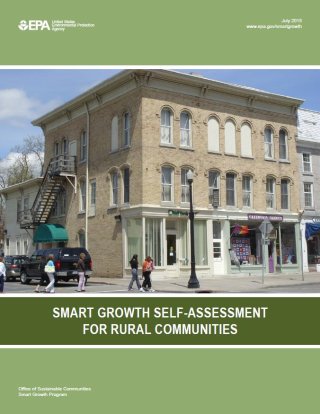Smart Growth Self-Assessment for Rural Communities
The Smart Growth Self-Assessment for Rural Communities is a compilation of strategies, organized by 11 common "goal areas," that villages, towns, and small cities can use to evaluate their existing policies to create healthy, environmentally resilient, and economically robust places.
On this page:
Background

This tool provides a checklist of smart growth strategies, which are organized into topical "goal areas," that are relevant to a variety of small towns and rural communities.
Representatives from local governments, community-based organizations, or volunteers can use this self-assessment to identify gaps in their policies, plans, codes, and programs; or simply learn more about common smart growth practices.
Given the diversity of rural communities, this tool also offers practices that a variety of places have used, with resources and examples from communities around the country. While the self-assessment tool provides examples of specific suggested strategies to address local challenges, it is not prescriptive. Rather, it can help prioritize strategies and identify low-hanging fruit that can move a community closer to its economic, social, and environmental goals.
This self-assessment was developed as part of EPA's Smart Growth Implementation Assistance project in Madison County, New York. For more information about the project, see Smart Growth Self-Assessment for Rural Communities: Madison County, New York.
You can also find more resources on smart growth in small towns and rural communities here.
Using the Tool
The Smart Growth Self-Assessment for Rural Communities tool is broad and interdisciplinary and can help communities identify gaps in their policies, plans, building codes, and zoning regulations by asking a series of "Yes" or "No" questions. All communities should begin by completing the self-assessment's Revitalize Village and Town Centers goal area, which gives a baseline indication of smart growth development policies within the jurisdiction. This section goes beyond regulatory issues to help communities take stock of their local initiatives, strategies, and plans.
The latter sections are not mandatory, and the community can complete the goal areas that are most relevant to them. Each of these sections focus on a specific set of issues and will likely require input from multiple parts of the local government, as well as from community residents and other partners.
Although the user does not necessarily need to complete all sections of the self-assessment, this tool works best when communities use it comprehensively, and a local leader - such as a mayor, city manager, town planner, or anyone with a broad community focus - facilitates the process.
Goal Areas
The individual goal areas of the self-assessment tool are organized as sections and are linked to fillable MS Word documents (which will download automatically when you click on the link) in the numbered list below. A link to the complete PDF is located at the top of the list.
Goal Areas
Smart Growth Self-Assessment for Rural Communities (pdf)
I. Revitalize Village and Town Centers (fillable version) (docx)
(mandatory)
II. Strengthen the Local Economy (fillable version) (docx)
XI. Use Energy Efficiently and Provide Renewable Energy (fillable version) (docx)
